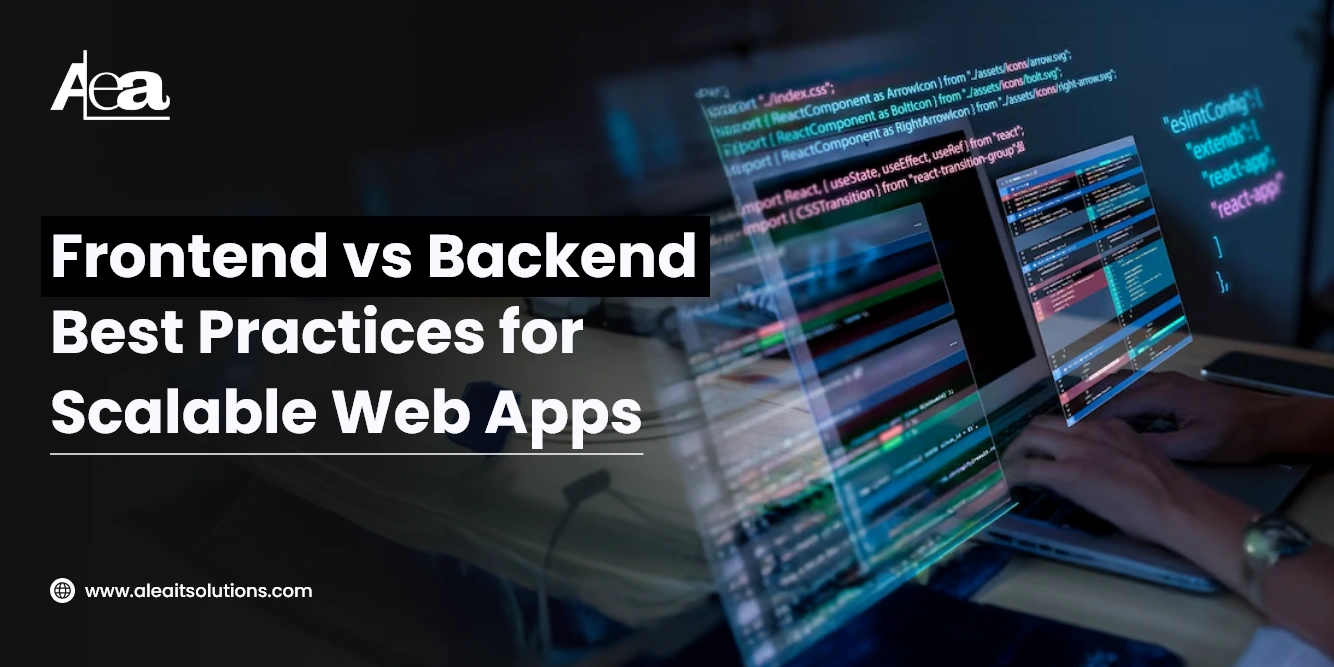In today’s digital economy, your web app is often your front door to users and first impressions matter. A sleek interface without strong foundations is like a beautiful shop built on shaky ground.
That’s why understanding frontend vs backend development and adopting best practices for scalable web apps isn’t just a technical concern — it’s a business imperative.
Consider this: forecasts estimate that global web and mobile traffic will continue doubling every few years as more services move online and users demand real-time responsiveness.
Organizations that scale poorly will buckle under spikes, slow down, or risk outages. On the other hand, apps built with clear architectural discipline, modular design, and attention to growth can handle that surge with grace.
In this post, we’ll talk about how frontend and backend roles complement each other, where common pitfalls lurk, and most critically what development patterns and practices make your web app durable, maintainable, and ready for growth.
Whether you’re deciding how to split responsibilities between teams or building your next high-traffic product, this is your playbook for scalable success.
1. What Is Frontend Development?
When you open a web app, what you see the buttons, animations, layouts, and visuals that’s the frontend at work. What you don’t see the data storage, server logic, authentication, and APIs that’s the backend running behind the scenes. Together, these two halves form the backbone of every digital experience.
In simple terms, frontend development shapes how users interact with your web app. It’s built with technologies like HTML, CSS, and JavaScript, often powered by frameworks such as React, Vue, or Angular.
The goal? To deliver a smooth, responsive, and accessible user interface (UI) that enhances the overall user experience (UX).
1.1. Key Technologies in Frontend Development
Frontend development is built on foundational technologies like HTML, CSS, and JavaScript, supported by tools such as TypeScript, Sass, and Webpack.
Frameworks like React and Angular simplify complex interfaces, while testing tools like Jest and Cypress ensure stability and performance. Responsive design principles help optimize user experiences across devices.
The global web performance market is expected to exceed USD 10 billion by 2030, reflecting the growing need for fast, scalable, and accessible websites.
Mastery of these technologies empowers developers to create high-performing, user-centric applications that drive engagement and business growth.
1.2. Popular Frontend Frameworks
Modern frontend development relies heavily on frameworks that streamline coding and enhance scalability. React, Angular, Vue.js, and Svelte are among the most popular, helping developers create dynamic and reusable user interfaces efficiently.
Frameworks like Next.js and Nuxt.js also support server-side rendering for faster loading and improved SEO. The web development market is forecasted to grow by over 10% annually, driven by the demand for interactive and mobile-first websites.
As a result, frontend frameworks have become indispensable tools for developers building responsive, high-performance digital products.
1.3. Core Responsibilities of Frontend Developers
Frontend developers are responsible for translating UI/UX designs into functional, visually engaging web interfaces. They focus on implementing responsive layouts, optimizing performance, ensuring accessibility, and maintaining browser compatibility.
Modern developers also apply techniques like lazy loading, caching, and code splitting to improve speed and efficiency.
With the growing emphasis on digital performance, frontend roles are expanding rapidly job demand has increased by more than 15% annually.
Ultimately, frontend developers bridge design and technology, creating seamless, interactive experiences that define how users connect with brands online.
What Is Backend Development?
Backend development ensures everything functions seamlessly underneath. This involves managing servers, databases, and application logic using tools like Node.js, Django, Laravel, or Spring Boot.
Think of the backend as the engine that keeps your app running handling user requests, processing data, and maintaining security and performance.
According to recent market reports, over 70% of development teams are now adopting full-stack practices, where frontend and backend developers collaborate closely.
This approach doesn’t just streamline communication — it enables the creation of scalable web apps that handle growth efficiently, without sacrificing speed or reliability.
2.1. Essential Backend Technologies
Backend technologies include programming languages like Python, Node.js, and Java, paired with databases such as PostgreSQL, MySQL, and MongoDB.
Cloud platforms like AWS, Google Cloud, and Azure enable scalability and data security, while tools like Docker and Kubernetes improve deployment efficiency.
The backend services market is expected to grow over 24% annually, driven by digital transformation and cloud adoption.
These technologies form the backbone of modern applications, helping developers build reliable, fast, and data-driven systems that support business operations and user experiences.
2.2. Common Backend Frameworks
Backend frameworks simplify development by providing pre-built structures for handling data, authentication, and routing. Popular frameworks include Django, Spring Boot, Express.js, and Laravel.
They allow developers to focus on logic rather than repetitive coding, ensuring faster and more secure application development.
The global backend software market is expected to surpass USD 1 trillion by 2026, emphasizing its expanding role in business applications.
With trends like microservices and API-first development gaining momentum, backend frameworks remain key to building scalable, high-performing digital platforms.
Read More: Top Frameworks for Front-End and Back-End Development
2.3. Primary Duties of Backend Developers
Backend developers design and maintain the systems that process data and power user-facing applications. Their responsibilities include building APIs, managing databases, ensuring security, and optimizing server performance. They collaborate with frontend and DevOps teams to deliver seamless digital solutions.
The backend development market continues to grow at a rapid pace, driven by the rise of cloud technologies and enterprise automation.
Backend developers are the unseen architects of digital ecosystems ensuring speed, scalability, and security for millions of users every day.
Frontend and Backend Development: Programming Languages and Their Roles
Frontend and backend development rely on distinct programming languages and app frameworks, each designed to address specific layers of a software application.
While frontend languages focus on what users see and interact with often using frameworks like React, Angular, or Vue.js backend languages power the logic, data management, and server communication behind the scenes through app frameworks such as Node.js, Django, or Laravel.
However, full-stack developers often bridge both domains, mastering tools from each side to build cohesive, end-to-end digital experiences.
Frontend Languages
The frontend is the visual layer that determines how users experience an application. It involves building layouts, animations, and responsive designs that adapt across devices.
- HTML (HyperText Markup Language): The backbone of web content, defining structure, headings, paragraphs, and multimedia placement.
- CSS (Cascading Style Sheets): Handles the presentation—design, colors, typography, spacing, and responsiveness—ensuring consistent visual appeal.
- JavaScript: Brings interactivity and dynamism to websites, enabling animations, data validation, and seamless real-time updates.
- TypeScript: A superset of JavaScript that introduces static typing, improving code reliability and scalability in large applications.
Together, these languages create the interface users see, touch, and navigate, focusing on performance and accessibility.
Backend Languages
The backend or server-side governs the logic that powers applications. It manages databases, authentication, and APIs that communicate with the frontend.
- Python: Renowned for its readability and extensive ecosystem, it’s widely used in AI, data science, and frameworks like Django and Flask.
- Java: A robust, secure choice for enterprise-grade systems and large-scale applications.
- Node.js (JavaScript): Enables asynchronous, event-driven programming for fast, real-time applications such as chats or gaming platforms.
- PHP: Powers dynamic content management systems like WordPress and frameworks like Laravel.
- Go & Ruby: Favored for simplicity, concurrency, and rapid development in modern web services.
Full Stack vs. Frontend vs. Backend
| Aspect | Frontend Developer | Backend Developer | Full-Stack Developer |
| Focus Area | User interface and design | Server logic and database | Both client and server side |
| Core Skills | HTML, CSS, JavaScript, React | Node.js, Python, SQL, APIs | Combination of both skill sets |
| Output | Interactive, responsive UI | Secure, scalable server | Complete web application |
| Project Phase | UI/UX implementation | Data handling & logic | End-to-end project delivery |
| Learning Curve | Moderate – visual and creative | Technical – logic-heavy | Steep – requires cross-discipline knowledge |
| Average Salary (2025) | $75K–$120K | $85K–$130K | $100K–$150K |
| Best For | Designers and creative coders | Analytical and logical thinkers | Versatile, independent developers |
Best Practices for Front-End and Back-End Integration
In the era of scalable web applications, seamless front-end and back-end integration determines the reliability, performance, and user satisfaction of your platform.
When both layers communicate effectively, you ensure faster load times, fewer bugs, and a smoother development workflow.
Below are industry-proven best practices for integrating front-end and back-end systems for scalability and long-term success.
1. Establish Clear Communication Protocols
The foundation of effective integration lies in clear communication and well-structured APIs between front-end and back-end teams.
Implementing RESTful APIs or GraphQL ensures efficient, predictable, and secure data exchange.
-
REST API: Follow standard HTTP methods (GET, POST, PUT, DELETE) for consistent and maintainable data transactions. REST is lightweight, cacheable, and ideal for high-traffic scalable web apps.
-
GraphQL: Enables clients to request only the specific data they need, reducing over-fetching and improving performance on complex data-driven interfaces.
Proper documentation is critical. Use tools like Swagger, Postman, or Stoplight to maintain comprehensive API documentation, ensuring both teams remain aligned as features evolve.
2. Implement Version Control for Collaboration
A robust version control system (VCS) like Git is vital for synchronized front-end and back-end development. It allows teams to track code changes, manage branches, and resolve conflicts efficiently.
-
Branching Strategies: Adopt structured workflows such as Git Flow or Trunk-Based Development to streamline collaboration.
These strategies help synchronize feature development, testing, and deployment without interrupting production stability.
This not only improves code quality but also enhances team productivity and CI/CD alignment.
3. Strengthen Authentication and Authorization
Security is at the core of any scalable web app. Both layers must handle authentication and authorization with a shared understanding of data privacy protocols.
-
Authentication: Verify user identity with secure standards like OAuth 2.0, JWT (JSON Web Tokens), or SAML.
-
Authorization: Control access based on user roles and permissions, ensuring sensitive data and actions are restricted properly.
Both teams should align on token storage, refresh flows, and session handling to prevent vulnerabilities such as CSRF or token leakage.
4. Utilize a Microservices Architecture
Modern scalable systems thrive on microservices architecture, where independent services handle specific business functions. This separation allows for independent development, deployment, and scaling without affecting other modules.
-
Service Isolation: Each microservice manages a dedicated feature (e.g., authentication, payments, notifications), simplifying updates and improving fault tolerance.
-
Technology Flexibility: Teams can use the most suitable tech stack for each service — for instance, Node.js for APIs and Python for data analytics — without creating dependencies.
Microservices enhance agility, speed up releases, and simplify scaling for enterprise-grade web apps.
5. Focus on Performance Optimization
Performance optimization is a joint effort between the front-end and back-end. Both teams should monitor data flow, loading behavior, and response times to ensure peak efficiency.
-
Front-End Optimization: Use lazy loading, code splitting, asset compression, and image optimization to minimize page load times.
-
Back-End Optimization: Improve performance with optimized database queries, asynchronous processing, and caching strategies (e.g., Redis or Memcached) to reduce latency and server load.
Together, these techniques enhance Core Web Vitals and user satisfaction — crucial for SEO ranking and conversion rates.
6. Maintain Consistent Coding Standards
A consistent coding style and structure ensures code readability, stability, and maintainability across both layers.
-
Use linting tools like ESLint, Prettier, or Stylelint to automatically enforce formatting rules.
-
Maintain shared style guides for naming conventions, folder structures, and commit messages.
This uniformity reduces integration friction and improves long-term scalability.
7. Automate Testing and Deployment
Automation is key to sustainable scalability. Implementing Continuous Integration/Continuous Deployment (CI/CD) pipelines ensures faster releases with fewer bugs.
-
Front-End Testing: Frameworks like Jest, Cypress, or Playwright validate UI functionality and integration points.
-
Back-End Testing: Use tools such as Mocha, Chai, or Supertest for API and logic validation.
CI/CD pipelines run automated tests for every code commit, enabling safe deployments and early detection of breaking changes.
8. Monitor and Analyze Application Performance
Post-deployment, continuous monitoring helps maintain performance and detect issues early.
-
Use Google Analytics, New Relic, or Datadog for real-time performance insights.
-
Apply centralized logging and monitoring tools like ELK Stack (Elasticsearch, Logstash, Kibana) or Grafana to track system health and user interactions.
Real-time monitoring ensures quick responses to performance degradation or errors, improving overall system reliability.
9. Ensure Responsive and Adaptive Design
With users accessing web apps across diverse devices, responsive design is a non-negotiable.
-
Leverage frameworks like Bootstrap, Tailwind CSS, or Foundation to maintain visual consistency across breakpoints.
-
Test on multiple devices and browsers to detect layout or performance issues early.
A responsive front-end integrated with a dynamic back-end guarantees optimal experiences for every user, regardless of device.
10. Encourage Cross-Functional Collaboration
Finally, successful integration thrives on collaboration and shared ownership.
-
Schedule regular sync meetings, joint code reviews, and pair programming sessions.
-
Encourage knowledge sharing to bridge technical gaps between UI/UX engineers and API developers.
This culture of collaboration reduces miscommunication, accelerates delivery, and enhances code quality — the cornerstone of scalable web application development.
Framework selection depends on project requirements, developer expertise, and integration needs. For instance, MERN stack (MongoDB, Express, React, Node) is widely used for startup MVPs, while Spring Boot suits enterprise-grade backend systems.
Industry Demand and Salary Trends
The demand for skilled developers continues to soar as businesses undergo digital transformation and embrace AI-driven ecosystems.
-
Frontend Developers:
With the growing focus on UX/UI and responsive design, frontend roles remain in high demand. Developers proficient in React or Vue.js can command annual salaries ranging from $75,000 to $120,000 in the U.S. (₹10–20 LPA in India).
-
Backend Developers:
Companies prioritizing scalable, secure systems specially in fintech, SaaS, and e-commerce — rely heavily on backend expertise. Backend developers earn between $85,000 and $130,000 annually (₹12–25 LPA in India).
-
Full-Stack Developers:
The hybrid skill set offers a competitive edge. These developers earn $100,000–$150,000 annually (₹15–30 LPA in India), depending on cloud, AI, or DevOps exposure.
Which Path Should You Choose?
Your choice depends on your interests, career goals, and problem-solving style:
- Choose Frontend if you love design, animations, and enhancing user experience.
- Choose Backend if you enjoy working with logic, data, and system performance.
- Choose Full-Stack if you prefer a holistic approach and want flexibility in building complete applications.
As AI, cloud computing, and web3 evolve, full-stack roles are becoming increasingly valuable, offering the perfect balance of creativity and logic in today’s tech-driven world.
FAQs:
1. How much does it cost to hire a frontend developer?
Hiring a frontend developer typically starts at $18 per hour or around $2,500 per month for a senior-level expert with 4–6 years of experience. Costs can vary based on technology stack (React, Angular, Vue), project complexity, and required design proficiency.
2. What is the average cost to hire a backend developer?
The average backend developer hiring cost ranges from $18/hour for individual engagement to $2,500–$3,000 per month for full-time senior backend developers experienced in Node.js, Django, Laravel, or Spring Boot. Enterprise-scale projects needing advanced architecture or cloud integration may cost higher.
3. Can I hire a full-stack developer instead of separate frontend and backend developers?
Yes. A full-stack developer can handle both the frontend and backend, helping you save on coordination time and cost. The typical price ranges from $2,500–$3,500 per month, depending on experience level and technology stack (e.g., MERN, MEAN, or LAMP).
4. What’s included in the $12,000 monthly Scrum team package?
The $12,000/month plan includes a complete Scrum development team of five members — typically a project manager, frontend developer, backend developer, QA engineer, and UI/UX designer. This option is ideal for startups and enterprises seeking agile development, continuous delivery, and full-cycle project management.
5. Is hiring developers on an hourly basis better than a monthly model?
It depends on your project needs:
-
Hourly model ($18/hour): Best for short-term projects, prototypes, or maintenance work.
-
Monthly model ($2,500/month): More cost-effective for long-term or ongoing development where consistent delivery and team alignment are key.
6. Do Alea developers work in different time zones or provide 24/7 support?
Yes. Developers are available in multiple time zones and follow Agile methodology for round-the-clock availability, daily stand-ups, and transparent progress tracking. This ensures faster delivery and better communication.
7. How do I choose between hiring frontend, backend, or full-stack developers?
-
Hire a frontend developer if your focus is on UI/UX, animations, and visual performance.
-
Hire a backend developer if your project needs strong server logic, APIs, or database management.
-
Hire a full-stack developer if you want a single resource to manage both client and server sides efficiently.
8. Why is hiring from Alea cost-effective compared to other agencies?
Alea offers direct communication, agile methodology, and cost transparency — cutting out third-party fees. With rates starting at just $18/hour, it’s one of the most cost-efficient ways to hire skilled developers without compromising quality or delivery speed.






